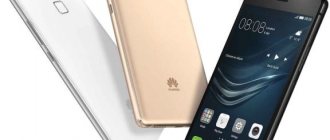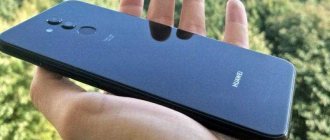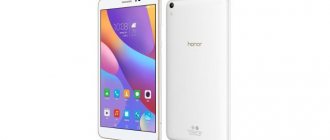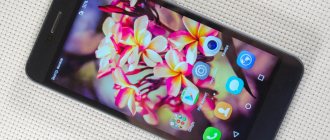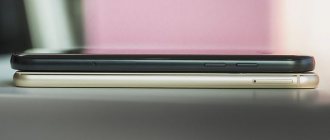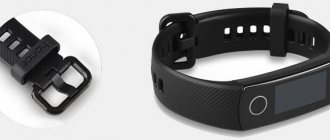Review of the Huawei Honor 7X smartphone and its characteristics
We received Huawei Honor 7X for review, which can be considered a prominent representative of the budget category, which is attracting more and more attention to the manufacturer. The main thing is that they did not save much on its production, offering balanced characteristics, a recognizable design and a really high-quality case. The device stands out for its 18:9 aspect ratio display and dual camera, which, combined with good battery life and a price of around $250, makes it a very interesting offer.
Honor 7X specifications:
- Display: 5.93 inches, 1080 x 2160, IPS;
- Processor: HiSilicon Kirin 659 (eight cores, 4 x 2.36 GHz + 4 x 1.7 GHz, Cortex-A53 core architecture) Mali-T830 MP2 graphics;
- RAM: 4 GB;
- Memory: 32/64/128 GB;
- OS: Android 7.0 Nougat shell EMUI 5.1;
- 2 nanoSIM cards;
- Main camera: 16 MP + 2 MP, 1/2.9″, phase detection autofocus;
- Front camera: 8 MP, ƒ/2.0;
- Battery: 3340 mAh, non-removable
- Fingerprint scanner;
- Dimensions: 156.5 x 75.3 x 7.6 mm
- Weight: 165 grams.
Buy a smartphone
Review of the Honor 7X smartphone with a metal case and a large screen
The Honor X series of smartphones is extremely popular among users of Honor products. It is, perhaps, more successful than other devices of this brand in combining decent technical characteristics and a truly affordable price. At one time, we witnessed the triumph of the 5X model, as well as a completely worthy continuation in the form of Honor 6X. Today it’s time to analyze in detail all the technical capabilities of the next representative of the legendary family - a smartphone called Honor 7X, presented at the end of the year in London.
Main characteristics of Honor 7X (model BND-L21)
- SoC HiSilicon Kirin 659, 8 cores Cortex-A53 ( [email protected] .4 GHz + [email protected] .7 GHz)
- GPU Mali-T830 (MP2)
- Operating system Android 7.0, EMUI 5.1
- Touch display IPS 5.93″, 2160×1080, 407 ppi
- Random access memory (RAM) 4 GB, internal memory 32/64/128 GB
- Nano-SIM support (2 pcs.)
- MicroSD support up to 128 GB
- GSM/GPRS/EDGE networks (850/900/1800/1900 MHz)
- WCDMA/HSPA+ networks (850/900/1900/2100 MHz)
- Networks LTE Cat.6 FDD (B1/3/7/8/20), TD (B40)
- Wi-Fi 802.11b/g/n (2.4 GHz)
- Bluetooth 4.1 BLE
- GPS, A-GPS, Glonass
- Micro-USB 2.0, USB OTG
- Main camera 16 + 2 MP, autofocus, f/2.2, video 1080p
- Front camera 8 MP, f/2.0, fixed. focus
- Proximity and light sensors, magnetometer, accelerometer, gyroscope, step counter
- Fingerprint's scanner
- Battery 3340 mAh
- Dimensions 157×75×7.6 mm
- Weight 165 g
| Average price of Honor 7X (32 GB) | Average price of Honor 7X (64 GB) | Average price of Honor 7X (128 GB) | |||
| find out prices | find out prices | find out prices | |||
| Honor 7X (32GB) retail offers | Honor 7X (64GB) retail offers | ||||
| find out the price | find out the price | ||||
Contents of delivery
Honor 7X is supplied for sale in a laconicly designed box made of hard matte blue cardboard with a white logo.
Our test device came with a standard charger without fast charging support (5V 2A), a USB cable and a card eject tool.
Appearance and ease of use
In design, Honor 7X is more reminiscent of the new product from the Huawei Nova 2 series than the flagship of its Honor 9 line. While the most noticeable detail of the body design is the luxurious glass back panel with a mirror backing, here the body is made entirely of matte metal.
At the same time, on Huawei Nova 2, our hero looks almost like two peas in a pod, with the exception of small touches, such as the shape of the grooves for the antennas and the location of the flash. There is also no bezel around the round fingerprint scanner area, and this is rather a plus. But straight grooves for antennas without curly bends are more of a disadvantage, since they visually make the design rough and straightforward.
There are no miracles; a smartphone with a six-inch display cannot be elegant. The Honor 7X body is large, heavy, and the hard matte metal surfaces glide very well in dry palms, everything is as usual. Fingerprints are also surprisingly visible on these matte surfaces.
The protective glass has sloping edges, and an LED event indicator is installed above the screen. Here, by the way, there are no angular curves of the screen itself, like many other “full-screen” devices with displays that have increased from 5.5 to 6 inches due to smaller frames.
The frame around the screen has not gone away; this is not a “frameless” option, as such “full-screen” smartphones are now called. From the sides it sometimes even turns out to be wider, but the segments at the top and bottom of new products with 18:9 screens have narrowed to about a centimeter or even more, this is a fact, and rather gratifying. But such smartphones do not have a fingerprint scanner or hardware touch buttons under the screen.
The fingerprint scanner has been moved to the back, its round area is located next to the eyes of the dual camera. These elements have the same diameter and are placed symmetrically, but due to the fact that both cameras protrude, it still looks worse than if the modules were combined behind a single glass, like the iPhone Plus series, for example. There is also a single LED flash on the back. It is curious that these three elements are located strictly along the groove with the antennas.
The lenses protrude beyond the surface, but the area of the back wall is so large (and it does not have bevels) that the smartphone lying on the table almost does not sway when you touch the screen. It is quite possible to work with a smartphone in this way.
You can install two SIM cards in your smartphone (both Nano-SIM formats) or replace one of them with a microSD memory card. Hot swapping of cards is supported.
The mechanical buttons on the right side are large, comfortable, and there are no complaints about them.
At the top end you can find only a small hole for the auxiliary microphone, and the 3.5 mm audio output for headphones, the conversation microphone and the main speaker are located at the bottom end.
The smartphone is available for sale in three colors: black, blue and gold.
Screen
Honor 7X is equipped with an IPS display covered with 2.5D glass with sloping edges. The physical dimensions of the screen are 68x136 mm with a diagonal of 5.93 inches, aspect ratio 18:9. At the same time, the screen resolution is 2160x1080 with a pixel density of about 407 ppi. The frame around the screen is approximately 4 mm thick on the sides, and a centimeter thick on the top and bottom.
It is possible to use automatic brightness adjustment based on the operation of the ambient light sensor. Multi-touch tests diagnose support for 10 simultaneous touches.
A detailed examination using measuring instruments was carried out by the editor of the “Monitors” and “Projectors and TV” sections Alexey Kudryavtsev . Here is his expert opinion on the screen of the sample under study.
The front surface of the screen is made in the form of a glass plate with a mirror-smooth surface that is scratch-resistant. Judging by the reflection of objects, the anti-glare properties of the screen are slightly worse than those of the Google Nexus 7 (2013) screen (hereinafter simply Nexus 7). For clarity, here is a photo in which a white surface is reflected in the switched off screens (on the left - Nexus 7, on the right - Honor 7X, then they can be distinguished by size):
The Honor 7X's screen is a little brighter (brightness according to photographs is 123 versus 116 for the Nexus 7). The ghosting of reflected objects in the Honor 7X screen is very weak, this indicates that there is no air gap between the layers of the screen (more specifically, between the outer glass and the surface of the LCD matrix) (OGS - One Glass Solution type screen). Due to the smaller number of boundaries (glass/air type) with very different refractive indices, such screens look better in conditions of intense external illumination, but their repair in the case of cracked external glass is much more expensive, since the entire screen has to be replaced. On the outer surface of the screen, there is a special oleophobic (grease-repellent) coating, which is better in efficiency than that of the Nexus 7. Therefore, fingerprints are removed much easier and appear at a lower speed than in the case of regular glass.
With manual brightness control and when the white field was displayed in full screen, the maximum brightness value was about 490 cd/m², the minimum was 2.5 cd/m². The maximum brightness is high, and given the good anti-glare properties, screen readability even on a sunny day outdoors should be at an acceptable level. In complete darkness, the brightness can be reduced to a comfortable value. There is automatic brightness adjustment based on the light sensor (it is located to the left of the front speaker slot). In automatic mode, as external lighting conditions change, the screen brightness both increases and decreases. The operation of this function depends on the position of the brightness adjustment slider; the user can use it to try to set the required brightness level in the current conditions. We slightly increased the brightness in complete darkness and got the following result: in complete darkness, the auto-brightness function reduces the brightness to 20 cd/m², in an artificially lit office (approximately 550 lux) it sets it to 190 cd/m², in a very bright environment (corresponds to the lighting on a clear day outdoors, but without direct sunlight - 20,000 lux or a little more) increases to 490 cd/m². We were quite pleased with the result. It turns out that the auto-brightness function works adequately and allows the user to customize their work to individual requirements. At any brightness level, there is no significant backlight modulation, so there is no screen flicker.
This smartphone uses an IPS matrix. The microphotographs show a typical IPS subpixel structure:
For comparison, you can see the gallery of microphotographs of screens used in mobile technology.
The screen has good viewing angles without significant color shift even with large viewing deviations from perpendicular to the screen and without inverting shades. For comparison, here are photographs in which identical images are displayed on the screens of Honor 7X and Nexus 7, while the screen brightness is initially set to approximately 200 cd/m², and the color balance on the camera is forcibly switched to 6500 K.
There is a white field perpendicular to the screens:
Note the good uniformity of brightness and color tone of the white field.
And a test picture:
The colors on the Honor 7X screen have a natural saturation; the color balance between the Nexus 7 and the tested screen is slightly different.
Now at an angle of approximately 45 degrees to the plane and to the side of the screen:
It can be seen that the colors have not changed much on both screens, but on the Honor 7X the contrast has decreased to a greater extent due to the greater brightening of blacks.
And a white field:
The brightness of the screens at an angle decreased (by at least 5 times, based on the difference in shutter speed), but in the case of the Honor 7X the drop in brightness is slightly greater. When deviated diagonally, the black field is lightened to a medium degree and acquires a purple tint. The photographs below demonstrate this (the brightness of the white areas in the direction perpendicular to the plane of the screens is the same!):
And from another angle:
When viewed perpendicularly, the uniformity of the black field is good:
The contrast (approximately in the center of the screen) is high - about 1600:1. The response time for the black-white-black transition is 22 ms (10 ms on + 12 ms off). The transition between halftones of gray 25% and 75% (based on the numerical value of the color) and back takes a total of 37 ms. The gamma curve, constructed using 32 points with equal intervals based on the numerical value of the shade of gray, did not reveal any blockage in either the highlights or the shadows. The exponent of the approximating power function is 2.09, which is slightly lower than the standard value of 2.2. In this case, the real gamma curve almost does not deviate from the power-law dependence:
We did not detect the presence of dynamic adjustment of the backlight brightness in accordance with the nature of the displayed image, which is very good.
Color gamut is close to sRGB:
The spectra show that the matrix filters moderately mix the components with each other:
As a result, visually the colors on this screen do not differ from natural ones. The balance of shades on the gray scale is good, since the color temperature is not much higher than the standard 6500 K, and the deviation from the blackbody spectrum (ΔE) is below 10, which is considered an acceptable indicator for a consumer device. At the same time, color temperature and ΔE change little from hue to hue - this has a positive effect on the visual assessment of color balance. (The darkest areas of the gray scale can be ignored, since color balance there is not very important, and the error in measuring color characteristics at low brightness is large.)
This device has the ability to adjust the color balance by adjusting the hue on the color wheel.
In the graphs above, the curves are Without corr. correspond to the results without any color balance correction, and the curves Corr. — data obtained after shifting the point to the position indicated in the image above. It can be seen that the change in balance corresponds to the expected result, since the color temperature has approached the standard value and ΔE has decreased on average. However, it doesn’t make much sense to make the correction. Note that this function is implemented more for show, since there is no numerical reflection of the correction and there is no field for measuring color balance.
To summarize: the screen has a high maximum brightness and has good anti-glare properties, so the device can be used outdoors without any problems, even on a sunny summer day. In complete darkness, the brightness can be reduced to a comfortable level. It is also possible to use a mode with automatic brightness adjustment, which works adequately. The advantages of the screen include the absence of an air gap in the layers of the screen and flicker, an effective oleophobic coating, good color balance and a color gamut close to sRGB. In general, the quality of the screen can be considered high.
Camera
The front camera has a sensor with a resolution of 8 megapixels. The lens has an f/2.0 aperture and fixed focus. The shooting quality here is average; there’s nothing particularly praising the Honor 7X’s selfie camera. Pictures taken in good lighting on the screen of the smartphone itself still look quite good, but when you start to look at the detail of pictures taken indoors, you can see that it is low, the matrix is noisy and its sensitivity is still not enough.
The rear camera here is double, but simpler than that of Nova 2. The main module has a 16-megapixel sensor, and the auxiliary one is only 2 megapixel. The camera is equipped with an f/2.2 aperture lens, there is no stabilization.
There's no intelligent scene recognition technology like in older models, but everything else is there, including a "wide aperture" mode for background blur. Naturally, there is also a Pro manual settings mode. In manual mode, you can adjust white balance, focus, photosensitivity, and exposure compensation.
The camera can shoot video in a maximum resolution of 1080p at 30 fps. There are no higher modes, no stabilization. The shooting quality is acceptable, not bad for this level of smartphone, but there’s nothing much to praise it for. Sound is recorded with high quality using sensitive microphones; the noise reduction system does not introduce noticeable distortion.
- Video No. 1 (44 MB, 1920× [email protected] fps, H.265, AAC)
- Video No. 2 (32 MB, 1920× [email protected] fps, H.265, AAC)
Below are examples of photographs with our comments on quality. Our specialist Anton Solovyov .
The camera turned out good. There are sometimes areas of blur at the edges, but overall the detailing even in distant plans is quite decent. In low light, the camera generally copes well. She is also good at shooting text and macro. In the pictures you can find traces of noise reduction and sharpening, but none of this is noticeable. As a result, the camera can be fully recommended for documentary and art photography.
Telephone and communications
Communication capabilities of Honor 7X include support for data transfer at speeds of up to 300 Mbps in LTE Cat.6 networks. In the urban areas of the Moscow region, the device behaves confidently, does not lose connection in places where reception is uncertain, and quickly restores the connection. Bluetooth has version 4.2, one Wi-Fi band is supported (2.4 GHz), there is no NFC module.
The navigation module works with GPS (with A-GPS), with the domestic Glonass and the Chinese Beidou. During a cold start, the first satellites are detected within tens of seconds, and the positioning accuracy is high. There is a built-in magnetic field sensor for compass operation.
The phone application supports Smart Dial, that is, while dialing a phone number, a search is immediately carried out by the first letters in contacts. Methods for setting up the sorting and display of contacts are standard for the Android interface; there is a blacklist for unwanted contacts. There is a function for automatically recording telephone conversations from the line. Medium power vibration alert.
The smartphone cannot support both SIM cards in 4G mode at the same time in active standby mode. Here, one SIM card (not the one selected for data transfer in 4G) will always work in standby only in 2G. The interface does not allow you to select a specific SIM card in advance for sending SMS - only for voice calls and data transfers (this is a standard situation for all Huawei smartphones). The cards operate in Dual SIM Dual Standby mode, there is only one radio modem.
Software and multimedia
The software platform used is Android OS, not the latest version 7.0, and Huawei's own shell, the latest version EMUI 5.1 - everything is the same as in other modern devices from the manufacturer. Naturally, there is the possibility of updating over the air (OTA).
The interface is designed in a familiar corporate style. There is a virtual button, a multi-window mode, the ability to reduce the keyboard and the working area of the screen in size. As usual, there are a lot of pre-installed applications, some of them are useful, others are clearly unnecessary. There are several of Huawei's own utilities, including a useful phone manager responsible for system monitoring, memory cleaning, virus scanning and protection, spam blocking, etc.
As for the so-called “full screen mode”, which appeared due to the changed aspect ratio and, accordingly, additional space on the screen, it is not occupied by default, gaping with black bars. It is possible to enter the settings and select the option of using “full screen mode” for each application, and after rebooting the application will be displayed in full screen.
To listen to music, you use, as usual, your own audio player with a familiar interface. Previously, it did not have any manual settings at all, and in new versions a Huawei Histen audio effects section has appeared, in which you can turn on the 3D sound effect and choose from equalizer presets - but all this becomes available only with connected headphones. In any case, both in headphones and through the speaker, the smartphone sounds quite satisfactory; the Honor 7X does not offer anything special in terms of sound, but the sound cannot be called low-quality.
The microphones have good sensitivity, the voice recorder is quite suitable for any task. There is a built-in FM radio, and this is good news.
Performance
The Honor 7X hardware platform is based on the HiSilicon Kirin 659 SoC. The chip configuration includes eight ARM Cortex-A53 processor cores in two clusters with a maximum frequency of 2.36 and 1.7 GHz. The SoC is made using a 16-nanometer process technology. The ARM Mali-T830 (MP2) video accelerator with support for the OpenGL ES 3.2 graphics API is responsible for graphics processing. The amount of RAM is 4 GB, the built-in flash memory in the case of our copy is 64 GB. Of these, 2.48 GB of RAM is free and only 48.5 GB of storage space, usually more than 50 GB. There are modifications of Honor 7X with a different amount of built-in memory.
It is also possible to expand the memory by installing microSD cards, but applications are not installed on the memory card. You can connect external flash drives in USB OTG mode.
SoC HiSilicon Kirin 659 is a relatively new solution designed for mid-range smartphones and tablets. The SoC is quite productive, at the level of Qualcomm Snapdragon 625; in the AnTuTu test, the hero of the review demonstrates a quite decent 60K-plus points, this is a confident average level.
Kirin 659 provides the system with sufficient performance and in real scenarios allows the smartphone to cope with any modern tasks. There are no problems with games either, all the games we tested, including Injustice 2 and Mortal Kombat X, run without any slowdowns; Lineage 2 can also be played quite comfortably without delays. However, the smartphone is designed more for today; there is no noticeable reserve of power for years to come.
Testing in comprehensive tests AnTuTu and GeekBench:
For convenience, we have compiled all the results we obtained when testing the smartphone in the latest versions of popular benchmarks into tables. The table usually adds several other devices from different segments, also tested on similar latest versions of benchmarks (this is done only for a visual assessment of the obtained dry figures). Unfortunately, within the framework of one comparison it is impossible to present the results from different versions of benchmarks, so many worthy and relevant models remain “behind the scenes” - due to the fact that they once passed the “obstacle course” on previous versions of test programs.
| Honor 7X (HiSilicon Kirin 659) | Sony Xperia XA1 (MediaTek MT6757) | HTC One X10 (MediaTek MT6755) | Asus Zenfone 3 (Qualcomm Snapdragon 625) | Nokia 5 (Qualcomm Snapdragon 430) | |
| AnTuTu (v6.x) (bigger is better) | 61810 | 61638 | 50597 | 63146 | 45287 |
| GeekBench (v4.x) (bigger is better) | 894/3345 | 814/3518 | 757/2071 | 831/4092 | 672/2867 |
Testing the graphics subsystem in gaming tests 3DMark, GFXBenchmark and Bonsai Benchmark:
When testing in 3DMark, the most powerful smartphones now have the ability to run the application in Unlimited mode, where the rendering resolution is fixed at 720p and VSync is disabled (which can cause the speed to rise above 60 fps).
| Honor 7X (HiSilicon Kirin 659) | Sony Xperia XA1 (MediaTek MT6757) | HTC One X10 (MediaTek MT6755) | Asus Zenfone 3 (Qualcomm Snapdragon 625) | Nokia 5 (Qualcomm Snapdragon 430) | |
| 3DMark Ice Storm Sling Shot ES 3.1 (bigger is better) | 409 | 671 | 421 | 466 | 299 |
| GFXBenchmark Manhattan ES 3.1 (Onscreen, fps) | 5 | 15 | 5 | 6 | 10 |
| GFXBenchmark Manhattan ES 3.1 (1080p Offscreen, fps) | 5 | 6 | 5 | 6 | 4,6 |
| GFXBenchmark T-Rex (Onscreen, fps) | 18 | 32 | 17 | 22 | 20 |
| GFXBenchmark T-Rex (1080p Offscreen, fps) | 18 | 21 | 17 | 23 | 16 |
Browser cross-platform tests:
As for benchmarks for assessing the speed of the javascript engine, you should always make allowance for the fact that their results significantly depend on the browser in which they are launched, so the comparison can only be truly correct on the same OS and browsers, and this is possible during testing not always. For Android OS, we always try to use Google Chrome.
| Honor 7X (HiSilicon Kirin 659) | Sony Xperia XA1 (MediaTek MT 6757) | HTC One X10 (MediaTek MT6755) | Asus Zenfone 3 (Qualcomm Snapdragon 625) | Nokia 5 (Qualcomm Snapdragon 430) | |
| Mozilla Kraken (ms, less is better) | 10080 | 9284 | 9992 | 8179 | 12559 |
| Google Octane 2 (bigger is better) | 3990 | 4489 | 3928 | 5036 | 2823 |
| SunSpider (ms, less is better) | 1353 | 946 | 1104 | 877 | 1970 |
AndroBench memory speed test results:
Thermal photographs
Below is a thermal image of the rear surface obtained after 10 minutes of running the battery test in the GFXBenchmark program:
It can be seen that the heating is more localized in the upper part of the device, which apparently corresponds to the location of the SoC chip. According to the heat chamber, the maximum heating was 39 degrees (at an ambient temperature of 24 degrees), which is not very much.
Playing video
To test the omnivorous nature of video playback (including support for various codecs, containers and special features, such as subtitles), we used the most common formats, which make up the bulk of the content available on the Internet. Note that for mobile devices it is important to have support for hardware video decoding at the chip level, since it is most often impossible to process modern options using processor cores alone. Also, you shouldn’t expect a mobile device to decode everything, since the leadership in flexibility belongs to the PC, and no one is going to challenge it. All results are summarized in a table.
| Format | Container, video, sound | MX Video Player | Standard player |
| 1080p H.264 | MKV, H.264, 1920×1080, 24 fps, AAC | plays normally | plays normally |
| 1080p H.264 | MKV, H.264, 1920×1080, 24 fps, AC3 | plays normally | There is video, but no sound |
| 1080p H.265 | MKV, H.265, 1920×1080, 24 fps, AAC | plays normally | plays normally |
| 1080p H.265 | MKV, H.265, 1920×1080, 24 fps, AC3 | plays normally | There is video, but no sound |
Further testing of video playback was performed by Alexey Kudryavtsev .
We did not find the MHL interface, like Mobility DisplayPort, in this smartphone, so we had to limit ourselves to testing the output of video files on the screen of the device itself. To do this, we used a set of test files with an arrow and a rectangle moving one division per frame (see “Method for testing video playback and display devices. Version 1 (for mobile devices)”). Screenshots with a shutter speed of 1 s helped determine the nature of the output of frames of video files with various parameters: the resolution varied (1280 by 720 (720p), 1920 by 1080 (1080p) and 3840 by 2160 (4K) pixels) and frame rate (24, 25, 30, 50 and 60 fps). In the tests we used the MX Player video player in the “Hardware” mode. The test results are summarized in the table:
| File | Uniformity | Passes |
| 4K/60p (H.265) | cannot be played | |
| 4K/50p (H.265) | Fine | No |
| 4K/30p (H.265) | Fine | No |
| 4K/25p (H.265) | Fine | No |
| 4K/24p (H.265) | Fine | No |
| 4K/30p | Fine | No |
| 4K/25p | Fine | No |
| 4K/24p | Fine | No |
| 1080/60p | Great | few |
| 1080/50p | Great | No |
| 1080/30p | Fine | No |
| 1080/25p | Fine | No |
| 1080/24p | Fine | No |
| 720/60p | Great | few |
| 720/50p | Great | No |
| 720/30p | Great | No |
| 720/25p | Fine | No |
| 720/24p | Fine | No |
Note: If both columns Uniformity and Skips have green ratings, this means that, most likely, when watching films, artifacts caused by uneven alternation and skipping of frames will either not be visible at all, or their number and visibility will not affect comfort viewing. Red marks indicate possible problems with playback of the corresponding files.
According to the frame output criterion, the quality of playback of video files on the screen of the smartphone itself is good, since in most cases frames (or groups of frames) can (but are not required) be output with more or less uniform alternation of intervals and without skipping frames. When playing video files with a resolution of 1920 by 1080 pixels (1080p) on a smartphone screen, the image of the video file itself is displayed exactly along the border of the screen, one to one in pixels, that is, in the original resolution. The brightness range displayed on the screen corresponds to the standard range of 16-235: perhaps in the shadows a couple of shades merge with black, but in the highlights all gradations are displayed.
Battery life
The non-removable battery installed in the Honor 7X has a capacity of 3340 mAh - this is a good amount even by today's standards. And with such a battery, the smartphone demonstrates results that are quite consistent with its level in autonomy tests. Considering the large screen with high resolution, the results are quite decent.
In real life, the device behaves the same way as most modern smartphones: it confidently survives until the evening charge, but you can’t count on more.
Testing has traditionally been done at normal power consumption levels without using power-saving features.
| Battery capacity | Reading mode | Video mode | 3D Game Mode | |
| Honor 7X | 3340 mAh | 12:00 pm | 10:00 am | 5:00 a.m. |
| Sony Xperia XA1 | 2300 mAh | 13:00 | 8:30 a.m. | 4 hours 10 minutes |
| HTC One X10 | 4000 mAh | 17:00 | 12:00 pm | 5:00 a.m. |
| Asus Zenfone 3 | 3000 mAh | 12:00 pm | 9:40 a.m. | 6:30 a.m. |
| Nokia 5 | 3000 mAh | 15:20 | 10:30 a.m. | 7:00 am |
Continuous reading in the Moon+ Reader program (with a standard, light theme) at a minimum comfortable brightness level (brightness was set to 100 cd/m²) with auto-scrolling lasted 12 hours until the battery was completely discharged, and when continuously watching videos in high quality (720p) with At the same brightness level via a home Wi-Fi network, the device operates for about 10 hours. In 3D gaming mode, the smartphone can work for no more than 5 hours.
Honor 7X does not support fast charging; from the included network adapter (2 A 5 V), the smartphone was charged for 2 hours 20 minutes with a current of 1.5 A at a voltage of 5 V. The smartphone also does not support wireless charging.
Bottom line
Prices for the Huawei Honor 7X smartphone start at €299 (or £269). In Russia, the device began to be sold in official retail on December 5; the recommended retail price for a modification with 64 GB of flash memory is currently 17 thousand rubles. For a nice smartphone from a popular brand with an attractive appearance, a practical all-metal body, a high-quality 6-inch screen with high resolution and a narrow frame, as well as quite decent hardware with good performance and support for LTE Cat.6 with high data transfer speeds, this is a completely reasonable price. The smartphone does not shine with shooting quality, but it would be stupid to expect this at such a price. We can also negatively highlight the lack of NFC (and therefore Android Pay). Otherwise, Honor 7X turned out to be a completely worthy successor to the glorious family of Huawei Honor in general and the Honor X line in particular.
Equipment
Honor 7X comes in a cardboard package with an unremarkable design. This immediately reveals that the device is a budget device. Everything inside is poor - if usually each accessory has its own space, then here everything is dumped into one heap. On top lies the Honor 7X, wrapped in a package, and besides it we find a charger with 5V / 1A parameters, a microUSB cable, a silicone case, documentation and a paper clip.
Performance
Honor 7X is built on the proprietary 16nm Kirin 659 processor. The eight-core chipset can operate at a maximum clock frequency of 2.36 GHz paired with an ARM Mali-830MP2 video accelerator. To process applications, the user has 4 GB of RAM available, and 64 GB of permanent memory (excluding OS data) on the internal drive is allocated for storing files. If this is still not enough, you can use a microSD card up to 256GB.
In terms of the smooth operation of the interface, the Honor 7X can be compared with flagships; even with a dozen applications open at the same time, the smartphone can easily perform “heavy” tasks. Benchmark testing results confirm the power level of the device. But in games with modern 3D graphics you will have to lower the settings. For example, in WoT: Blitz at maximum speed the fps level sometimes drops to 25 frames per second.
Design of Huawei Honor 7X
The manufacturer remains true to its traditions, continuing to develop an interesting design concept. The Honor 7X looks simply amazing. Metal was used to make the back side, and the front panel is covered with 2.5D glass. Almost the entire area is occupied by a large display, which looks very nice. The only thing we will miss is the fingerprint scanner built into the Home key. It moved to the back cover. But this is not done as clumsily as in the Galaxy S8 - it is easy to find by touch and does not cause any discomfort.
The Huawei Honor 7X review informs you that a version with gold, blue and classic black casing is available for sale. It looks best in blue - an unusual solution, while other colors have long become standard.
The arrangement of functional elements is familiar. On the right is the power and volume control button.
On the left is a tray in which you can install two SIM cards at the same time or one paired with microSD.
Everything else was placed at the bottom - a headphone jack, which fortunately was not abandoned, a speaker, a microphone and a microUSB port. The latter is a little disappointing, because in 2021, almost all devices receive improved USB-C, which supports fast charging and other benefits.
From the back side, the device looks quite nice - there is a plastic strip running above and below for the antennas, which harmoniously fits into the design. There is a dual camera module in the upper left corner and a single-section flash on the left side of it. The fingerprint scanner is located in the center - it is very easy to find blindly. Just below is the corporate logo.
As expected, the build quality is at the highest level; you wouldn’t expect anything else from Huawei. The smartphone fits well in the hand, despite its diagonal of 5.93 inches.
Appearance
The review included the Honor 7X in black. The austere metal case is thin - 7.6 mm and fits comfortably in the hand thanks to its rounded shape. At the same time, the metal is quite slippery; fingerprints are visible on its surface. The assembly is flawless, even the mechanical keys located on the right, which often have play in more expensive smartphones, sit tightly in place and are pressed clearly. The antenna strips on the top and bottom of the body do not stand out, but slightly dilute its black monotony.
A pair of lenses protruding from the body attracts attention, as does the fingerprint sensor pad at the top of the back of the device, the LED event indicator and the only Honor logo on the front panel. The SIM card tray on the left side of the smartphone, on the contrary, is invisible, and the microphone hole for the noise reduction system on the top end of the case is almost invisible.
The connectors on the bottom edge of the device are arranged as standard. From left to right there are: a 3.5 mm headset jack, a Micro-USB port, a speaking microphone and a ringing speaker.
Thus, the exterior of the Honor 7X turned out to be unimpressive. And, obviously, it was made this way deliberately so as not to distract attention from the smartphone screen.
Display
Honor 7X reviews positively mention the display and, as our review showed, it is really good here. The smartphone has a screen with a diagonal of 5.93 inches, FullHD+ resolution (2160x1080 pixels) and an increasingly popular, although still rare, aspect ratio of 18:9. With these characteristics, the pixel density is 407 per inch - an excellent result. The picture turns out to be highly detailed, no matter how hard you try, but individual pixels cannot be seen. To extend battery life, you can set the display resolution to a lower resolution in the settings menu.
The screen did not have rounded edges, which became fashionable in 2017. But it is covered by a protective glass designed using 2.5D technology. There is no air gap, so the image literally lies on the surface. Colors are not distorted even when using the Honor 7X at extreme angles. A high quality oleophobic coating was applied to the surface of the display. The brightness reserve is enough for comfortable work both in the sun and in a dark room.
If this is your first acquaintance with 18:9 screens, then the impressions will be incredible. As a result, you simply cannot go back to standard 16:9 displays; they will seem like last century, outdated technology. Huawei Honor 7X 32gb review revealed that not all content is displayed in this format yet; if there is no support, then the image is displayed in the standard 16:9 ratio, and small black bars appear at the edges.
In most cases, this misunderstanding is eliminated by pre-installed software that adjusts the picture to the 18:9 ratio. But it still doesn’t cope with its work everywhere; for example, there are frames on YouTube. Over time, the problem will lose its relevance; now all new applications will be released with support for this format. The screen occupies 77% of the front surface area, which is very impressive.
Design
The first and most important thing you need to know about the appearance of Honor 7X. A smartphone in renders and in real life are two different devices. The device looks much better in the hands than in the photographs.
How was it for me?
Initially, I was not eager to take the Honor 7X for review . However, the public still had interest in the new product, and I really liked its predecessor. In general, I decided to give the device a chance. And after turning on the device, I realized that everything was not in vain.
The smartphone turned out to be fiery!
And of course, the reason for this is the 5.93-inch display with a fashionable 18:9 aspect ratio.
It's amazing how a trend started at the beginning of the year and by Samsung by the end of the same year has turned into a mass phenomenon.
The 18 by 9 proportions are not just a stupid and useless copy of the flagship chips. On the contrary, this gives manufacturers a chance to increase the screen area without affecting the dimensions of the smartphone. And Honor 7X is direct confirmation of this.
| Length | Width | Thickness | Weight | |
| Honor 7X (5.93'') | 156,5 | 75,3 | 7,6 | 165 |
| Honor 6X (5.5'') | 150,9 | 76,2 | 8,2 | 162 |
| Xiaomi Mi A1 (5.5'') | 155,4 | 75,8 | 7,3 | 165 |
| Meizu M6 Note (5.5'') | 154,6 | 75,2 | 8,4 | 173 |
By the way, it is in white that Honor 7X looks especially good. In black and blue colors, minimal frames do not look like an advantage; they are perceived as usual. So if you buy a smartphone, then only in a light case.
Neatly rounded corners, excellent assembly, relatively minimalistic design - in terms of appearance, the smartphone cannot be undermined.
The device looks and feels much more expensive in the hands than it actually costs.
Except that the two camera eyes and the fingerprint scanner vaguely resemble a crazed minion.
Performance of Huawei Honor 7X
The Honor 7X is clearly not designed for gaming, although it does everything else perfectly. No matter how good the device looks, the filling must be appropriate, and here there are problems with this. Huawei Honor 7X characteristics are based on an 8-core processor of its own production - Kirin 659, which is comparable in performance to Snapdragon 625. Thanks to the 16-NM process technology, it spares battery power and practically does not heat up. It has a clock speed of up to 2.36 GHz. The graphics accelerator is the Mali T830 MP2, which is significantly inferior to the Adreno 506.
Huawei Honor 7X synthetic test results
As the Huawei Honor 7X 5.93 review showed, there will definitely be no performance problems in everyday use, but it won’t be able to handle games at maximum graphics. In heavy games there are even slight stutters. In Tanks, the game will be comfortable only on medium and low graphics; at maximum, fps drops significantly. The good thing is that there is no heating - even after a long game the case remains barely warm.
The review of the Huawei Honor 7X smartphone showed that in addition to other characteristics, it comes with 4 GB of RAM, which ensures the ability to work simultaneously with several applications without slowdowns and repeated downloads. The amount of internal memory depends on the modification - 32, 64 or 128 GB.
Iron
The performance of the Honor 7X is driven by an eight-core system on a chip developed by Huawei engineers. The Kirin 659 is split into two core clusters clocked at 2.36 and 1.7 GHz and includes a Mali-T830 GPU. The amount of RAM on board the Honor 7X is 4 GB, permanent memory is 64 GB. It is possible to increase storage using MicroSD cards up to 128 GB.
The Honor 7X passed the set of tests that every smartphone goes through with dignity, but not without problems. For example, a benchmark such as Epic Citadel refused to load from Google Play at all. Having tested Honor smartphones before, we have not encountered such problems. However, over time, the processors of the Kirin line have not become any worse. They still feel confident in the mid-range and make Honor devices responsive when navigating menus and fast in most applications.
At the same time, the Mali-T830 MP2 graphics accelerator was installed in the Kirin 650 and even then could not boast of performance reserves for the future. Over time, it did not become faster, but the system requirements of the games, although not much, grew. In them, the frame rate does not rise above 30 FPS, and in some projects that are especially demanding on graphics performance, it remains at the level of 15-20 frames per second.
The fingerprint sensor built into the back of the smartphone can only be praised. It works without any exaggeration instantly and without error.
Huawei Honor 7X interface
While reviewing the Huawei Honor 7 X, we made sure that it runs on the proprietary EMUI 5.1 shell. The Russian language is available out of the box, and all interface elements are well translated. It is convenient to use, there are many available gestures and the ability to flexibly configure each element. Google services and applications from the manufacturer are preinstalled. But there is also some Chinese software that you immediately want to remove. To avoid this, buy the global version. The shell is one of the best. You will find in it many truly necessary functions that the original Android lacks.
Interface
EMUI 5.1 includes a number of applications from Huawei. There are applications for graphic themes, healthcare, custom calendar, notepad, file manager, mail and others. The email client can be called quite good, but it does not know how to set automatic XML settings in Office 365 and Exchange Servers, so setting up some accounts will not be easy. The level of customization here also leaves much to be desired.
Most custom apps have a rounded floating toolbar at the bottom. The buttons now have text labels that allow you to quickly identify applications. They are located at the bottom of the screen, where you can easily reach them with one hand. These are two important aspects of user experience that many developers ignore.
The design of the Music app can be praised. There is no support for cloud services, as in Google Play Music or other multimedia players, but there are no advertisements, only music.
The settings section offers many customization options. You can change the style of the home screen, choose a different arrangement of navigation buttons, enable fingerprint scanner gestures, manage application permissions, set applications to run two copies with different accounts.
Some stability issues have been discovered. Camera apps, Xbox, Facebook and others crashed. Hopefully, software updates will fix these problems.
Autonomy of Huawei Honor 7X
Although the Huawei Honor 7 X received a more capacious 3340 mAh battery, you shouldn’t expect miracles from it. The manufacturer tried to maintain a balance so that the smartphone could confidently survive until the evening charge, but at the same time its body remained moderately thin, which a powerful battery would not have allowed to achieve. An energy efficient processor also plays a role in this. With active use, Honor 7X discharges after 5 hours of display activity.
The proprietary EMUI shell is well optimized and contains an effective power saving function, thanks to which you can further improve the results. It unloads applications from memory that you have not used for a long time. As a result, autonomy can be increased to two days.
As the Huawei Honor 7X review showed, in video playback mode, about 10% of the charge is consumed per hour, and in games, the sadder picture is up to 30% per hour. The results are average, taking into account the not very productive hardware and large display. Unfortunately, the smartphone was left without fast charging technology, which is why you have to wait 2.5 hours from 0 to 100%.
Let's sum it up
We studied the update to the Honor smartphone line and came to the conclusion that the company does not change production traditions. We have before us a high-quality device, the development of which took time and considerable effort. It has a good 3340 mAh battery, a responsive interface, a fast fingerprint scanner and large amounts of memory on board. And yet, the attempt to modernize the company's products was only partially successful.
Honor 7X combines recent trends: a frameless screen and a dual camera. If the first one made a positive impression, then the camera, despite the second lens, turned out to be weak. The reason for this, of course, is the cost limitations of the device, but it seems that it is not worth sacrificing image quality in pursuit of trends. The savings could go towards Wi-Fi that supports the 5 GHz band or an NFC chip.
Pros:
- Frameless screen;
- Large amount of RAM and built-in memory;
- Fast EMUI.
Minuses:
- Long charging time;
- Low quality of night photography;
- There is no reserve of graphics performance.
May not like:
- Wi-Fi only supports the 2.4 GHz band;
- No NFC chip.
Cameras Huawei Honor 7X
Huawei Honor 7X camera review reveals noticeable improvements over its predecessor. The only thing that is a little alarming is that the manufacturer does not disclose information regarding the manufacturer of the sensors and their characteristics. In tribute to trends, the main module is dual - 16 and 2 megapixels. The second sensor is monochrome and is used primarily to create the Bokeh effect. The main one did not have the best aperture - f/2.2, which is why the quality of the images noticeably drops as lighting conditions worsen.
For its price, the camera is decent; during the day, it takes stunning pictures with good detail and contrast. But the color rendition is far from the reference - the picture turns out pale. For advanced users, Huawei Honor 7X has a manual shooting mode. Although modern phones rarely have problems with this. But night photography is a completely different matter, as this is where all the camera’s flaws appear.
Example photo on Huawei Honor 7X
In low light, the quality of the images noticeably drops. But if you perform serial shooting, then at least 1-2 frames will be successful. What helps is the flash, which is moderately bright, but does not overexpose nearby objects.
The Huawei Honor 7X smartphone review showed that the camera does an excellent job of blurring the background. It's not as beautiful when compared to more expensive flagships, but for the price it's just perfect. The user can adjust the intensity of the blur. A big plus is that the Bokeh effect can be added to a ready-made photo in the gallery.
Video shooting is carried out at 30 frames per second and in FullHD resolution. If you don’t shake the smartphone too much, the quality is decent.
The 8 MP front camera with f/2.0 aperture takes good pictures and will definitely appeal to those who cannot live without Instagram and bright selfies. The interesting thing is that even the front camera can shoot frames with a background blur effect. Even though software algorithms are used for this, it turns out well. Huawei Honor 7X 64gb review showed that, for a budget device, the cameras are very good.
Conclusion
To summarize, we can say with confidence that Honor 7X has become a worthy representative of the budget segment. It has a bright and recognizable design, high build quality, high-quality cameras and an intuitive interface. The screen doesn’t disappoint either; its unusual side resolution and large diagonal make it an ideal content player. Autonomy is certainly not record-breaking, but at a quite decent level. A strange decision was the manufacturer’s use of an outdated microUSB port, which again means there is no fast charging. Other dubious points include a lack of performance for demanding games, the lack of an NFC chip, and not support for all domestic LTE frequencies.
Where can I buy?
Following the links you can buy a smartphone at the best prices:
Aliexpress GearBest Banggood
Comments for the site
Cackl e
Huawei Honor 3C is a modern smartphone with excellent characteristics
Huawei Honor 5c - review, price and specifications
Huawei Honor 6 is a bright flagship that contributes to the formation of a good image of the company in the global market
Huawei Honor 6X smartphone review - dual camera and good battery life at a cost of up to $200
Review of the Huawei Honor 7S smartphone - a budget phone on Android Oreo with many disadvantages
Huawei Honor 6C Pro is a bright representative of the budget category
Review of Huawei Honor 9 Lite - what did you have to sacrifice to significantly reduce the price of the flagship?
Review of Huawei Honor V10 - an interesting smartphone with artificial intelligence
Review of Huawei Honor 8X - a powerful phone with an edge-to-edge screen and NFC at a price below 20,000 rubles
Review of the Huawei Honor 8 smartphone and its characteristics
Honor 8 Lite is a great option for its price
Camera
According to the brochures, the Honor 7X's dual camera will make you feel like a real photographer thanks to its portrait mode. This functionality is implemented using a combination of a 16 megapixel color matrix and a 2 MP black and white sensor.
Portrait mode doesn't work perfectly, but it's quite possible to get nice photos with it. In general, the implementation is not much worse than that of competitors.
What's more interesting is how the camera behaves in everyday use. During the day, the pictures turn out to be sharp and quite detailed, but in a series of frames taken literally one after another, the exposure noticeably “walks.” Some photos turn out lighter, others darker. The quality of night photography, alas, does not stand up to criticism: low clarity, artifacts and insufficient aperture of the optics. However, you don’t often come across something better in this price segment.
The advantages of the photographic part of the smartphone include support for the latest version of the camera API and an extremely functional viewfinder program. It implements: HDR, panoramas, a special mode for creating light graffiti, slow and accelerated shooting, color filters, and even more additional modes downloaded through a separate menu.
The front camera has an 8MP sensor and takes quite typical selfies. We only note the built-in function of applying face masks in real time and the screen flash.

